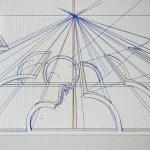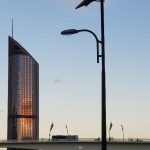Ipswich artist Allan Tulloch received the Queensland Regional Art Awards Digital Art Award in 2017 for his digital performance piece entitled Float. Part of his prize was a six-day residency at The Edge, State Library of Queensland. Allan blogged about his experiences learning to develop his artistic practice using new media such as 3D printing and laser cutting.
Day 1 – Feb 5
First day of my residency at The Edge started with coffee with Daniel Flood from The Edge and Kerryanne Farrer from Flying Arts Alliance (one should never forget the Alliance part of the organisation).
I brought along work from my series “Whatever”. “Whatever” is a growing body of works that explores desires for performance enhancement in AFL football. It consists of tiny carvings about the size of pills but the expressive focus goes beyond the taking of sports-enhancing drugs. Each pill is a variant of an abbreviated image of an AFL field (for those not acquainted with the game).
My aim on day one was to see if these tiny sculptures could be 3D printed. I was introduced to Tinkercad and made a few prototypes.
Ok – so the prototypes did not render the fine detail that I hoped for. This was especially noticeable in the limited capacity to capture the rise of the surface in the middle of the tablet.
Project for Day 2 – explore a different 3D project.
Day 2 – Feb 6
I am not daunted by yesterday’s results with 3D printing of a prototype pill. I decided to set my sights on a project that has been on a back burner for a few years.
Also focusing on sport, I have a work that explores rugby league. But before I go into this, I must emphasise that I do not play any of the sports I investigate. I watch sports highlights. I rarely watch a full game unless I am doing particular research.
My attention to sport is part of a broader project aiming to refigure ideas about masculinity. I have chosen to do this through a window of traditional male dominated work and play. And the play is most often explored through sport.
Back to the main game.
In many of my sports works I materialise my ideas through reconfigurations of sports fields. The sports fields often signify aspects of a game that relate to gender relatable characteristics. In this sketch the 10 metre lines become airborne agents rather than passive markers.
Using Tinkercad I explored how I may take my concept to being a material sculpture. As Tinkercad does not appear to be capable of making twists, I had to carve forms to get close to twists. Once semi-twisted I had to integrate them into the drawing.
This was hard going but at least I was able to navigate around my artwork to see if it was doing the right thing from many angles.
Fortunately, sitting beside me was an Edge volunteer who suggested that the answer might be in laser cutting. He suggested that sections laser-cut in clear acrylic with twists being done through heating the acrylic. He demonstrated how the acrylic could be bent and I could see that it would be very effective. Even the clear nature of the acrylic would add to the explorations within the work.
So the stage is now set to get the angles of the elevated red bars worked out so as to proceed to making drawings for laser cutting.
Day 3 – Feb 7
The challenge of Day 3 was to advance yesterday’s drawing so that only one side of the model had even blue curves and red bars. Overnight I hatched an idea to solve the problem of not having twists in Tinkercad – I could dot the path of the twists with a path of little spheres.
The dotting worked but the process is reasonably laborious. The main objective was to get the red bars angled and in the most dynamic location. The capacity to rotate the drawing allowed me to virtually sculpt the curves into oft altering red bar positions. The video reveals where the dots are sloppy and allows me to review the location of the bars.
So apart from the mechanics of developing my artwork and being able to put in more than eight hours a day on my project, the stay near the heart of Brisbane is great.
The staff at The Edge are very helpful and it has been interesting to see how they function in the setup and to learn about what they bring to The Edge. This evening I was able to put in a brisk walk along South Bank for exercise before enjoying a sushi meal. Back at the hotel I was a bit shamed to find that room servicing had come to my aid by washing up my dishes! Must not let that happen again.
Day 4 – Feb 8
So today, I did start the day by washing my dishes!!
Today was almost exclusively devoted to dotty spheres, nudging them into position, rotating the drawing to check on dotty sphere positions and, most importantly, getting the skewed red bars into the most dynamic positions.
I have been having lunch at the State Library cafe, surfing the vegetarian options as I usually don’t have meat at lunchtimes. I have also started having afternoon coffee at the upstairs version of The Edge at Coffee Start.
When I started at The Edge on Monday, upstairs was closed to the public and fitted with my past impressions of the place – nothing significant seemed to be happening. But of course I was always only just passing and I can’t be sure of what times I was passing.
Tuesday totally changed my impressions of The Edge upstairs. At 12 noon Tuesday to Sunday this space draws in people who use nooks to tutor students, hold small meetings, have coffee, charge laptops while working with them and I don’t know what else. But the place is abuzz and the view is million dollar.
And back to downstairs, where I have been working, is what is called the Fab Lab. Fab has a dual meaning as fabrication and fabulous, I suppose. Fab Lab draws in its own crowd of makers from 12 on Tuesday, Wednesday, Thursday and Saturday. People are able to develop individual projects using resources ranging across sewing machines, 3D printers, laser cutters, routers, soldering irons, silicone form casting etc.
After going out for dinner with my son Ben, we came back to find Fab Lab ramped up into Hack the Evening, a weekly meetup event where creators get to use whatever gear and materials they can find hoarded in The Edge’s basement. More people, more projects, more buzz! Mick gave Ben and I a quick tour, finishing off suggesting that I should get to doing some laser cutting before my week was up. I had the project but was not quite ready for it – this was to become my Friday morning challenge.
Day 5 – Friday Feb 9
I have spent a few days working out the 3D details of my Rugby League artwork.
My challenge to get started with doing some laser cutting before the end of my residency was my main aim for the day.
The morning was devoted to taking measurements from my Tinkercad into drawing one side of the artwork.
The even curves on one side of the sculpture were easy but getting the dimensions for the skewed bars boiled down to guesstimation.
The skewed curves will be heated and bent to meet up with the positions of the skewed bars. These curves may be too short or long. They may have the wrong
curve. The first laser cut will try out the guesstimations. If inaccurate, my source drawing will be adjusted.
Sooo, the drawing took till 1pm – didn’t think it would take that long…
After lunch I worked with Mick to set up the drawing in Coreldraw to be sent to the lasercutter. This process happened without a problem giving me my prototype for one side of the artwork.
With my time in the residency drawing to a close, my challenge for Saturday will be to work out how to hold the skew bars in place prior to bending the skew curves. The adventure continues.
Day 6 – Saturday Feb 10
On this morning I had to locate myself upstairs as there was a scheduled workshop in the Fab Lab – different makers learning how to make silicone moulds.
Armed with one of The Edge’s laptops with Adobe Ilustrator, I was able to enjoy the view of the river while I worked.
Today’s task was to design small stands to temporarily hold my skew bars in place for when I will heat and bend the skew curves of acrylic to meet these bars. Sounds a bit skewiff doesn’t it – anyway it is okay in my head (I hope).
The task was time consuming, individually taking dimensions from Tinkercad to design freestanding supports in Illustrator. This took all day (!!!!!), fortunately alleviated by having lunch with my wife, Darlene, at the Library Cafe.
So, the artwork has not been fully realised during the residency. But I now have a link for me to be able to book times to use the laser cutter when the Fab Lab is open to the community.










